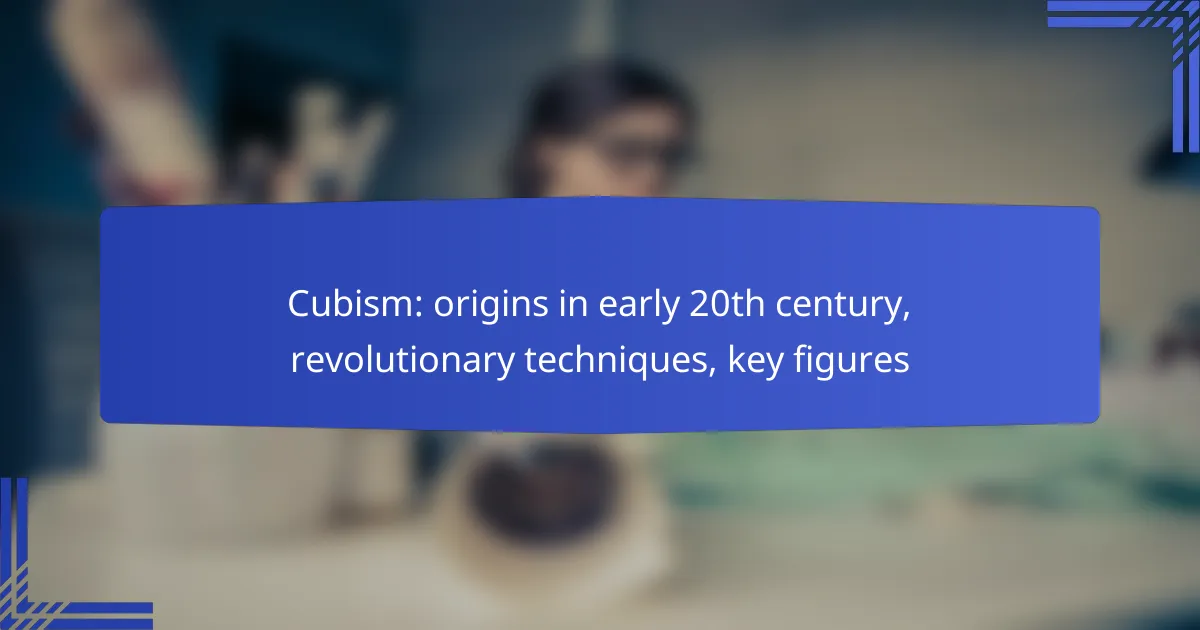Cubism emerged in early 20th century Europe as a groundbreaking art movement that revolutionized traditional representation by emphasizing fragmented forms and multiple viewpoints. This innovative approach, led by key figures such as Pablo Picasso and Georges Braque, transformed the way subjects were depicted, fostering a new understanding of reality through geometric abstraction and dynamic composition.

How did Cubism originate in early 20th century Europe?
Cubism originated in early 20th century Europe as a revolutionary art movement that broke away from traditional perspectives, emphasizing fragmented forms and multiple viewpoints. This innovative approach aimed to depict subjects in a more abstract and dynamic manner, influencing various artistic disciplines.
Influence of Post-Impressionism
Post-Impressionism played a crucial role in the emergence of Cubism by challenging the conventions of representation and perspective established by Impressionism. Artists like Vincent van Gogh and Paul Cézanne explored color and form in ways that encouraged later Cubist artists to deconstruct objects into geometric shapes.
Cézanne’s focus on the underlying structure of objects, rather than their surface appearance, particularly inspired Cubist pioneers to experiment with abstraction and the representation of three-dimensional space on a two-dimensional plane.
Development in Paris
Paris became the epicenter of the Cubist movement, attracting artists from various backgrounds who sought to innovate and collaborate. The city’s vibrant art scene, characterized by salons and exhibitions, provided a fertile ground for ideas to flourish and evolve.
Key figures such as Pablo Picasso and Georges Braque began working closely together in the early 1900s, sharing techniques and concepts that would define Cubism. Their interactions led to the establishment of distinct phases within the movement, including Analytic and Synthetic Cubism.
Key events leading to Cubism
Several pivotal events contributed to the rise of Cubism, including the 1907 exhibition of Picasso’s “Les Demoiselles d’Avignon,” which shocked audiences with its radical departure from traditional representation. This work is often cited as a turning point that paved the way for Cubist exploration.
The 1911 Salon d’Automne also marked a significant moment, showcasing works by both Picasso and Braque, further solidifying Cubism’s place in the art world. These events, alongside the influence of African art and the burgeoning avant-garde movements, shaped the trajectory of Cubism and its impact on modern art.

What revolutionary techniques define Cubism?
Cubism is characterized by innovative techniques that break away from traditional representation in art. Key techniques include geometric abstraction, multiple perspectives, and fragmentation of form, each contributing to a new way of seeing and interpreting reality.
Geometric abstraction
Geometric abstraction in Cubism involves reducing subjects to their basic geometric shapes, such as cubes, spheres, and cones. This technique emphasizes structure over realism, allowing artists to explore the essence of their subjects rather than their surface details.
For example, a still life might be depicted using overlapping shapes that suggest the arrangement of objects without showing them in a conventional manner. This abstraction can create a sense of depth and movement, inviting viewers to engage with the artwork on a more intellectual level.
Multiple perspectives
Multiple perspectives is a hallmark of Cubism, where artists depict a single subject from various viewpoints simultaneously. This technique challenges the traditional notion of perspective, presenting a more comprehensive view of the subject.
For instance, a portrait might show the front and side of a face at the same time, allowing the viewer to perceive the subject in a dynamic way. This approach encourages a deeper understanding of the subject’s form and context, reflecting the complexity of human experience.
Fragmentation of form
Fragmentation of form involves breaking down subjects into distinct, often disjointed parts that are reassembled in a new composition. This technique creates a sense of disorientation and invites viewers to piece together the narrative or meaning behind the artwork.
Artists like Pablo Picasso and Georges Braque often employed this method, leading to works that appear both chaotic and harmonious. By presenting fragmented elements, they challenge viewers to reconsider their perceptions and engage with the artwork actively.

Who are the key figures in the Cubism movement?
The Cubism movement features several pivotal figures, with Pablo Picasso and Georges Braque being the most prominent. These artists, along with Juan Gris, played crucial roles in developing and popularizing Cubism’s revolutionary techniques and styles in the early 20th century.
Pablo Picasso
Pablo Picasso is often regarded as the co-founder of Cubism, alongside Georges Braque. His work, particularly the painting “Les Demoiselles d’Avignon,” marked a significant departure from traditional representation, embracing fragmented forms and multiple perspectives.
Picasso’s innovative approach included the use of geometric shapes and a limited color palette, which helped convey depth and structure. His ability to blend various influences, from African art to classical forms, made his contributions to Cubism both diverse and influential.
Georges Braque
Georges Braque, a close collaborator of Picasso, was instrumental in the development of Cubism. His works, such as “Violin and Candlestick,” exemplify the movement’s emphasis on breaking down objects into geometric shapes and reassembling them in abstract forms.
Braque’s exploration of color and texture further enriched Cubism, as he often employed a muted palette to focus on form rather than vibrancy. His innovative techniques, including collage and the use of mixed media, expanded the boundaries of artistic expression during this period.
Juan Gris
Juan Gris is recognized for his unique contribution to Cubism, often referred to as “synthetic Cubism.” His works, such as “The Breakfast Table,” combine elements of collage and vibrant colors, distinguishing his style from that of Picasso and Braque.
Gris’s approach involved integrating various materials and textures, which added depth and complexity to his compositions. His ability to balance abstraction with recognizable forms made his work accessible while still challenging conventional artistic norms.

What impact did Cubism have on modern art?
Cubism significantly transformed modern art by introducing new ways of seeing and representing reality. It broke away from traditional perspectives, allowing artists to depict subjects from multiple viewpoints simultaneously, which influenced countless movements that followed.
Influence on abstract art
Cubism laid the groundwork for abstract art by emphasizing form and structure over representational accuracy. Artists began to explore the use of geometric shapes and fragmented forms, leading to movements such as Futurism and Constructivism. This shift encouraged a focus on color, line, and composition as primary elements of artistic expression.
Key figures like Pablo Picasso and Georges Braque demonstrated how abstraction could convey emotion and meaning, paving the way for later artists to experiment with non-representational forms. The legacy of Cubism is evident in the works of artists like Wassily Kandinsky and Kazimir Malevich, who further pushed the boundaries of abstraction.
Shifts in artistic expression
The techniques developed during the Cubist movement prompted a reevaluation of artistic expression, encouraging artists to break conventions. This led to a more personal and subjective approach to art, where individual interpretation became paramount. Artists were no longer confined to realistic depictions but could explore themes and ideas through innovative visual languages.
This shift also fostered collaboration among artists, as seen in movements like Dada and Surrealism, which embraced the experimental spirit of Cubism. The emphasis on multiple perspectives and fragmented realities influenced not just painting but also sculpture, architecture, and design, reshaping the entire landscape of modern art.

How did Cubism evolve over time?
Cubism evolved through distinct phases, primarily transitioning from Analytic Cubism to Synthetic Cubism. This evolution marked a shift in techniques and styles, reflecting broader changes in the art world during the early 20th century.
Transition to Synthetic Cubism
The transition to Synthetic Cubism occurred around 1912, characterized by a move away from the fragmented forms of Analytic Cubism. Artists began to incorporate mixed media and collage techniques, using materials like paper, fabric, and even found objects to create more vibrant and textured compositions. This phase emphasized the use of color and simplified shapes, allowing for a more expressive representation of subjects.
Synthetic Cubism also introduced the concept of creating art that was less about direct representation and more about the interplay of forms and ideas. Artists like Pablo Picasso and Georges Braque experimented with layering and juxtaposition, which encouraged viewers to engage with the artwork on a more conceptual level.
Integration with other art movements
Cubism significantly influenced and integrated with various other art movements, including Futurism, Dada, and Surrealism. The emphasis on abstraction and the breakdown of traditional perspectives resonated with these movements, leading to innovative approaches in visual art. For instance, Futurists adopted Cubist techniques to convey motion and dynamism, while Dadaists used collage to challenge conventional aesthetics.
Moreover, the integration of Cubism with these movements often resulted in collaborative exhibitions and cross-pollination of ideas. This synergy not only broadened the scope of modern art but also laid the groundwork for later developments in abstract art, ensuring that Cubism remained a pivotal force in the evolution of 20th-century art.

What are the characteristics of Synthetic Cubism?
Synthetic Cubism is characterized by the use of simplified shapes, vibrant colors, and the incorporation of mixed media. This artistic movement, emerging in the early 20th century, focused on creating compositions that combined various elements to depict subjects from multiple viewpoints.
Use of mixed media
The use of mixed media in Synthetic Cubism involves integrating different materials and textures into a single artwork. Artists often combined traditional painting techniques with materials like paper, fabric, and found objects to create depth and complexity. This approach allowed for a more tactile experience and challenged the conventions of painting.
For example, artists like Pablo Picasso and Georges Braque frequently used newspaper clippings and wallpaper in their works, which added layers of meaning and context. This technique not only enhanced visual interest but also connected the artwork to contemporary life.
Collage techniques
Collage techniques are central to Synthetic Cubism, as they involve assembling various elements to form a cohesive piece. Artists would cut and paste different materials, creating a juxtaposition of images and textures that conveyed a sense of fragmentation and reconstruction. This method emphasized the idea of viewing a subject from multiple angles simultaneously.
Common pitfalls in collage techniques include overcomplicating the composition or neglecting the balance between different elements. To achieve harmony, artists should consider the color palette and spatial arrangement carefully, ensuring that each component contributes to the overall narrative of the artwork.

What are notable Cubist artworks?
Notable Cubist artworks include pieces that exemplify the movement’s innovative approach to form and perspective. These works often break subjects into geometric shapes and present multiple viewpoints simultaneously, challenging traditional representation.
Key Cubist artworks
Some of the most famous Cubist artworks include Pablo Picasso’s “Les Demoiselles d’Avignon” and Georges Braque’s “Violin and Candlestick.” These pieces are recognized for their radical departure from realism and their introduction of abstract forms. Other significant works are Juan Gris’s “The Breakfast Table” and Fernand Léger’s “The City,” which further illustrate the evolution of Cubism.
Characteristics of Cubist art
Cubist art is characterized by fragmented objects and a focus on geometric shapes. Artists often used muted colors in the early phase, known as Analytic Cubism, to emphasize structure over color. In the later phase, Synthetic Cubism, brighter colors and mixed media became prominent, allowing for more expressive compositions.
Impact on modern art
The impact of Cubism on modern art is profound, influencing various movements such as Futurism, Constructivism, and Abstract Expressionism. By challenging conventional perspectives, Cubism opened the door for artists to explore abstraction and conceptual representation. Its legacy continues to inspire contemporary artists and remains a pivotal reference point in art history.
